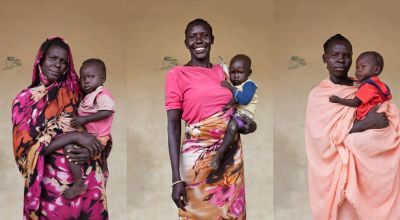
Read our 2023 annual report

Knowledge Hub
One person is forcibly displaced every 2 seconds – but not all displacements are the same.
At the beginning of 2022 – before the Ukraine crisis took shape – more than 92 million people worldwide had been forced to flee their homes. That figure accounted for:
- 20.8 million refugees
- 50.8 million internally-displaced people (IDPs)
- 4.4 million asylum-seekers
- 4.2 million stateless persons
- 3.9 million Venezuelans displaced abroad
- 8.4 million people of concern to the United Nations High Commissioner for Refugees
Additionally, 5.7 million Palestinians are registered under the mandate of the United Nations Relief and Works Agency for Palestine Refugees in the Near East (UNRWA).
What’s the difference between a refugee and a migrant? What about a refugee and an IDP? Often, the terms are used interchangeably. Yet each of these designations is a legal status with its own unique meaning. And those differences matter.
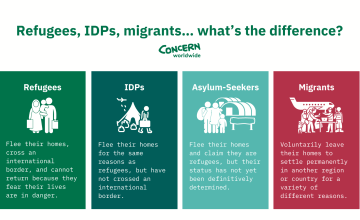
What is a refugee?
Refugees are people who have fled their homes, crossed an international border, and cannot return because they fear their lives are in danger. People become refugees when one or more of their basic human rights are violated or threatened.
Because of this, refugees receive a number of protections under international law, the most important being ‘non-refoulement.’ This means that refugees have a right to be protected by the country in which they seek asylum, and can’t be forced to return home. They also have the right to education, employment, healthcare, and freedom of movement under the UNs 1951 Refugee Convention, although these rights are often violated.
However, there are some complications that come with being a refugee. ‘Refugees don’t always settle in the country in which they first sought asylum,’ explains Abby Bruell, Concern’s Senior Policy Officer. ‘Often, they leave the first country because of economic hardships and go elsewhere.’
"Being a refugee is a last resort."
What is an IDP?
IDPs have been forced to flee their homes for the same reasons as refugees but have not crossed an international border. IDPs live in their countries of origin but are often afraid or unwilling to return home for fear of persecution.
We most often talk about refugees, but – as noted in the numbers above – there are far more IDPs in the world today. ‘Being a refugee is a last resort,’ says Bruell, who also notes that IDPs often relocate several times over within their own country.
Although many IDPs face the same difficulties as refugees, they aren’t granted the same rights under international law – ‘internally displaced person’ is a descriptive term, not a legal one. While assistance to refugees is a legal requirement, the principles on internal displacement are non-binding. IDPs still have rights, but some governments are unable or unwilling to honour those rights. So while this is the largest population of displaced people, it’s also one of the most vulnerable.
What is an asylum-seeker?
Asylum-seekers are people who have fled their homes and claim international protection, but whose status has not yet been definitively determined. Every refugee begins as an asylum-seeker, but not every asylum-seeker will be granted refugee status.
National asylum systems are responsible for evaluating and qualifying asylum-seekers for international protection. Those who do not qualify for refugee status can be sent back to their home countries.
"Every refugee begins as an asylum-seeker, but not every asylum-seeker will become a refugee."
What is a migrant?
Migrants are people who move between temporary homes, either within their home country or internationally. This is different from an immigrant, who makes the conscious decision to move and resettle in a new country. Migrants aren’t forced to leave their country of origin due to violence, but often have just as urgent needs to find a better future, such as a lack of work in their country of origin.
According to The Office of the United Nations High Commissioner for Human Rights, there are currently 244 million people living outside their country of origin, all of whom are known collectively as ‘migrants.’
Like refugees, legal migrants are protected by the rights of the country in which they’re living. However, migrants who travel without valid passports or travel documents – including those who were forced to flee without those documents, or do not have them - are often much more vulnerable.
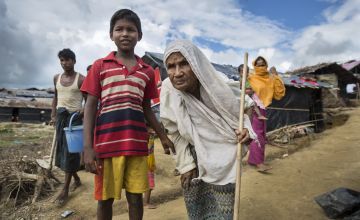
What is a stateless person?
Stateless people are those who are not considered a national by any state. It may be due to discrimination against minority groups in national laws, failure to include all citizens when a state becomes newly independent, or conflict of laws between states.
Putting all of this together: A (hypothetical) case study
Consider this example: Omar is a young Syrian man fleeing violence in Homs. He makes a dangerous journey across the Mediterranean and arrives in Greece. There, he ends up in a refugee camp where he’s unable to move around freely and has no opportunity for work.
A friend and fellow Syrian living in Sweden tells Omar he can get a decent job and apartment in the country and helps Omar fly to Sweden. This is where things get complicated, as different countries interpret the law in different ways.
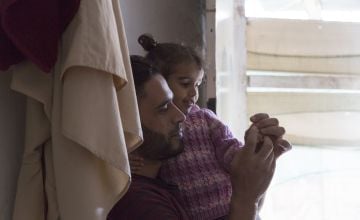
Technically, Omar began his journey in Greece as an asylum-seeker. The main issue would then be whether or not he claimed and was granted refugee status. If he did, he would not be entitled to claim asylum in Sweden as well, unless he applies for it and goes through an approval process that could take several years. So in Sweden, he might be classified as a migrant. This would cost him the special rights and protections he had as a refugee.
However, if Omar never officially applied for asylum in Greece, his status is much less clear. There is no legal obligation for refugees to seek asylum in a particular country. However, the ‘first country of asylum’ principle means that refugees are commonly expected to seek asylum in the closest country that can offer them protection. In that case, Omar may be denied entry in Sweden and sent back to Greece for his claim to be determined.
Why this all matters
Many refugees find themselves in situations like this. Desperate to provide a better life for their families after reaching a place of safety, they move to another country where they may not be given refugee status but stand a better chance of employment. However, without the special protections afforded refugees, they’re forced to live and work ‘under the radar,’ vulnerable to abuses of their rights. Migrants in this situation may be exploited by employers, their children may be denied an education, and they may not be able to access health care.
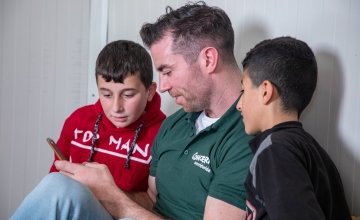
Concern’s work with refugees, asylum-seekers, migrants, and IDPs
Concern’s response to the world’s displacement crisis is in keeping with the Comprehensive Refugee Response Framework (CRRF), approved by all 193 Member States of the United Nations in September, 2016.
While every emergency situation has its own unique considerations and challenges, the CRRF gives a set of guidelines for approaching the predictable aspects of these crises. This includes:
- Easing pressure on countries that welcome and host refugees
- Building self-reliance of refugees
- Expanding access to resettlement of refugees in third countries or offering other complementary pathways
- Fostering conditions that enable refugees to voluntarily return to their home countries
Last year, Concern responded to 78 emergencies in 23 countries – many of which included providing support within the CRRF to refugees, asylum-seekers, and IDPs. Much of our work also impacts the lives of migrants and their families (often separated by international borders for months at a time). Our emergency response last year reached 17.9 million people with urgent necessities such as shelter, healthcare, and food as well as longer-term livelihoods trainings that benefit both displaced and host communities.




